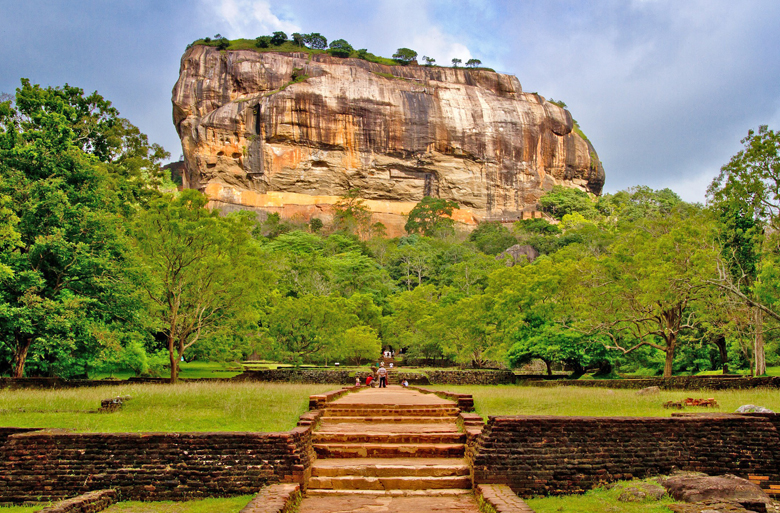Sigiriya or Sinhagiri or the Lion’s Rock is an ancient rock fortress – archaeological site located in the Matale district, in the Central province of Sri Lanka.
It contains the ruins of an ancient palatial complex, built during the reign of King Kasyapa (477-495).
Sigiriya is presumed to have been inhabited since prehistoric times. It was used as a monastery nestled in the rock since the 3rd century, with caverns prepared and donated by Buddhist devotees.
The Garden and the palace were built by Kasyapa. After the death of Kasyapa, it remained a monastic complex until the fourteenth century, after which it was abandoned. The ruins were discovered in 1908 by British explorer John Still.
The “Ancient City of Sigiriya” is listed as a UNESCO World Heritage Site since 1982. It consists of two rectangular enclosures surrounded by two trenches and three embankments where two palaces are located.
The entrance to the site is located on the western side of the complex, where a small museum is located.
Today the massive column of rock nearly 200 metres (660 ft) high It is one of the most popular tourist destinations in the country.
Access : Coordinates: 7.956944, 80.759722 / To reach Sigiriya from the Bandaranaike International Airport in Colombo, it takes just over 3 hours by car. /
There are options in public transport such as train and bus that although they take twice as long they have good prices. Keep in mind that these transports do not reach the archaeological site and forces you to take a taxi that makes the journey more expensive.
Attractions – site layout :
- Sigiriya Lion Rock Fortress : This fortress is a natural watchtower that served as an element of vigilance and defense since it allowed to see enemies from afar. After a long history of about 5000 years, it was abandoned, being rediscovered in 1908.
After conquering the more than 1200 steps on winding spiral stairs, limestone steps and the huge gardens, you will reach the top of the Sigiriya rock.
Here, on top of Sigiriya’s rock was the King’s complex, complete with bathing pools, royal rooms and the King’s throne. - Sigiriya Museum. oenig hours : 8:30 – 17:30. Admission Fee : Price included in the entrance fee to Sigiriya rock, the Museum alone is 5 USD
- The Apsara paintings, One of the most famous features of the Sigiriya complex are the fifth-century paintings found in a depression on the rock face more than 100 metres above ground level. These paintings can be reached by a spiral staircase.
where you will see the paintings of half-naked women in the stone, made with the technique of “frescoes”.There are references in the graffiti to 500 ladies in these paintings.
The true identity of the ladies in these paintings still have not been confirmed. - Mirror wall : King Kassapa had in the rock of Sigiriya the famous Kat Bitha, or mirror wall, made to satisfy his decadent tastes. The gallery wall is made of brick, with a bright and reflective layer of egg white and porcelain. Many believe that this reflective surface was designed to help the king see his reflection as it passes.
- Gardens : The Gardens of the Sigiriya city are one of the most important aspects of the site :
- Lion’s door: The remains of the lion’s door only reveal part of what it should have been: the head of a lion with its legs on the ground where the entrance was made through the jaws of the animal.
- Upper palace: the upper palace, on top of the rock, still has cisterns cut into the stone, where you can still find water. Remains of the palace, terraces, bathrooms and gardens still show the exceptional construction.
- Terraced gardens : The Sigiriya terraced gardens are formed from the natural hill at the top of the Sigiriya rock , The path through the terraced gardens is formed by a limestone spiral staircase.
- Boulder gardens : The gardens extend from the northern slopes to the southern slopes of the hills at the foot of Sigiris rock.They were used it as a defense measure to be pushed off from the top to attack enemies when they approached.
- Water Gardens : One of The first attraction one would encounter after entering the complex is the water gardens , It is an elaborate network of water pavilions, pools, courtyards and water courses. There are five units in this garden complex with buildings supported by pools.
- Fountain Gardens : There are four fountains symmetrically built, with two on each sides of the footpath. These fountains were fed by two moats which are adjacent to these fountains. Water is carried to the fountains by underground water conduits and work on simple principles of gravity and pressure.
Opening Hours: Every day from 6:30 am. at 6:00 p.m. / Admission Fee: 3600 LKR / $ 30 (USD).
Activities : photo opportunities- photography trips / sightseeing /
Go next :Pidurangala Ancient Forest Monastery / Mapagala fortress / Dambulla / Kandy / Kaudulla National Park / Minneriya National Park / Trincomalee / Sinharaja Forest Reserve

